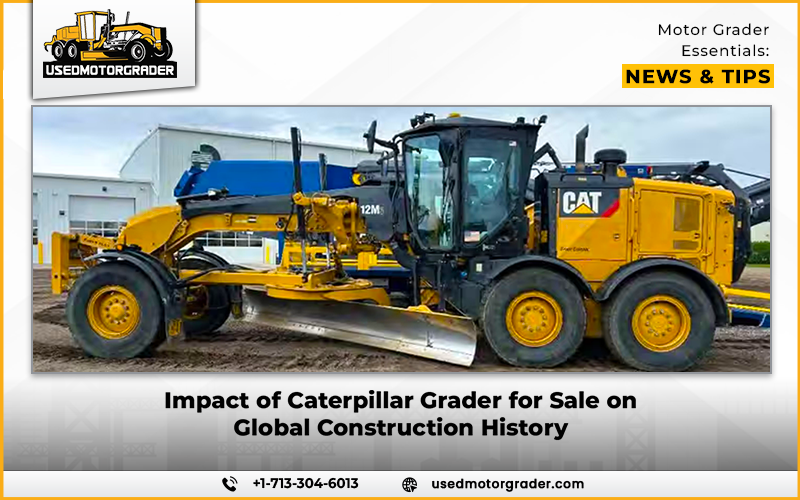Early Developments in Earthmoving
When motor graders were not the powerful machines they are today, road construction was back-breaking. Consider horse-drawn blades and never-ending physical work. However, with the appearance of the internal combustion engine, everything started to change. Caterpillar had a significant role in this change. When they began to construct their early self-propelled graders, it was not only a mechanical improvement it was the start of something that would create the modern construction world. These early caterpillar grader-for-sale models introduced power, uniformity, and volume to grading tasks, and roadwork was much quicker and much more efficient.
Caterpillar’s Golden Era: Standardizing the Industry
Several decades later, caterpillar grader for sale models were the gold standard on any job site. The 12- and 14-series machines were not only rugged, but they were reliable and a workhorse that you could depend on even in harsh conditions. Their designs contributed to what contractors started to demand of graders in general: good balance, good visibility, and sensitive controls. Other companies began imitating Caterpillar, including competitors and training schools. And after you had used one, you knew why so many operators and fleet managers stayed with the brand.
Innovations That Changed the Game
What kept Caterpillar ahead wasn’t just its build quality. It was the way the company constantly looked to improve how graders actually performed on the job. Adding articulated frames was a game changer, giving operators better handling and flexibility. Hydraulic controls replaced mechanical ones, offering smoother, more accurate blade movement. Then came power shift transmissions, which made shifting feel effortless and intuitive. These upgrades weren’t bells and whistles. They addressed real-world job site frustrations, and the difference was obvious as soon as you climbed into the cab.
Global Reach: Caterpillar Graders on the World Stage
Caterpillar grader for sale models didn’t just make their mark in the U.S. You’ll find them in every corner of the globe, from building roads in African villages to prepping runways in remote Arctic towns. These machines became symbols of progress in emerging economies, and their reliability made them a smart bet in areas where service and parts weren’t always close by. The global dealer support system helped, too. Communities and contractors could count on a steady supply of components, know-how, and training no matter where they were working.
Operator Culture and Machine Legacy
Sit around with a veteran grader operator, and you will hear him talk about Caterpillar machines as though they were old friends. This is because Cat graders are not mere tools. They are a tool of a craftsperson. The balance, blade control, and general feel of the job made it not only easier but also more satisfying. There are also operators who even favor some models and would seek them when changing jobs. Such a personal touch eventually became the legacy of Caterpillar in the hearts of people who use heavy equipment in their daily lives.
Economic Influence: Resale and the Secondary Market
The second big contribution Caterpillar graders made to the industry? Resale value. These are durable machines, and the market is aware of this. That is why even Cat graders as old as 10 years or more are still commanding good prices, particularly in overseas markets. Contractors in areas with smaller budgets tend to purchase used Caterpillar machines since they are aware that they are purchasing durability, even though the machine has high hours. This resale cycle formed a worldwide ecosystem in which Cat graders are still sold and used over the years.
Transitioning Into the Digital Age
Although tech has transformed the construction industry, Caterpillar has not been left behind. Modern graders are full of digital capabilities- GPS-guided blade control, onboard diagnostics, and remote monitoring via telematics. These additions provide contractors with greater accuracy, improved data, and closer control of productivity and maintenance. It also fits into the tech seamlessly, and it complements what the experienced operators already know how to do, instead of superseding them. And in the case of fleets, this development implies a smarter approach to machine, fuel, and uptime management without altering what is effective.
How the Past Shapes the Future of Grading
The history of Caterpillar in the grader market is not historical; it is the roadmap of the future of the industry. With the needs of the jobsites changing and the emphasis shifting to sustainability, efficiency, and intelligent systems, the decades of experience Cat has developed in refinement are more applicable than ever. The machines are changing, and the core, rugged reliability, operator-focused design, and long-term value are still there. You can be driving a 50-year-old Cat grader or a new, high-tech one, but you are enjoying the benefits of a history that is still defining the dirt under our feet.


